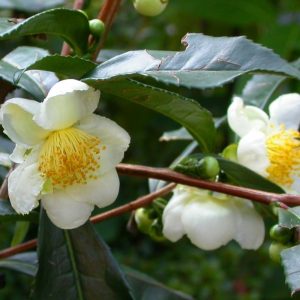Camellia Sinensis – Tea plant

The tea plant, Camellia Sinensis (L.) is a species of plant belonging to the Camellia genus and the Theaceae family, from whose leaves tea is obtained, the beverage with multiple properties, second only to coffee in diffusion. Whether we are talking about black tea, green tea or white tea, all these types of tea come from Camellia Sinensis, therefore from the same plant, and differ in type of harvest and processing, which follows traditional processes. The tea plant is one of the crops with the most ancient history: its origins and consumption of the drink are traced in the millennium preceding the birth of Christ, we must wait for the second half of the 16th century and the Hispanic-Portuguese trade network for the arrival of the tea plant in Europe, where, initially used by wealthy people for its beneficial properties, it begins to spread as a drink for consumption, especially in England. It is the British who brought tea cultivation to India and Sri Lanka, in the colonial period, today among the two main world producers of tea. The name tea derives from the Chinese ‘tay’ which then resulted in the different linguistic variants, such as tea.
GROUND
The tea plant needs to be grown in temperate climates (between 10 ° and 30 °) with regular rains in fact it generally grows very well in tropical and subtropical climates. Camelia Sinensis can also be cultivated both in sunny areas and in more humid areas, provided that the soil is fertile enough; the ideal soil for growing the tea plant is acidic, without water stagnation.
FLOWERS AND FRUITS
The plant is made up of alternating simple leaves, of a dark and intense green, with flowers that take on a red, white or intermediate color between the two, depending on the different types. It is an acidophilic species for which attention must be paid to the type of substrate in which it is planted and to the fertilizer used for its development.
The tea plant offers a harvest starting from 3-5 years of age, and is grown up to about 1-1.20 m in height, to create a suitable harvest conformation: follow the growth and cultivation with painstaking attention. of Camellia sinensis is of fundamental importance, because if it were left to natural growth it would become a tree, instead to favor the harvest it is grown as an evergreen bush. The tea plant is an erect shrub, whose leaves have an ovate-sharp shape and are 4 to 15 cm long, and the flowers have a white color and yellow stamens.
The collection of tea leaves from Camellia Sinensis takes place at different times of the year, and the time of harvest is a great factor in determining the variety of tea: in fact, a collection of the first leaves is carried out, which lead to a more valuable and of quality and produced in smaller quantities, and then of the leaves that are found further down. Usually the collection of tea leaves takes place 3 or 4 times a year, in the coolest hours of the day, at sunrise and sunset: the times and methods vary according to the plant, height and quantity, and generally the the most abundant harvest is the autumn one, while the most valuable harvest is the spring one. Harvesting of tea leaves is usually done by hand, and takes about two weeks, but in some plantations the process is mechanized.
USE AND HEALTHCARE CONTENT
For centuries, tea has been used for its beneficial properties, in particular tea made from the leaves of Camellia Sinensis, taken as a drink, in general has astringent, antibacterial, antiviral and antioxidant properties, as well as stimulating the nervous system. Tea is also an energizer and a stimulant, containing caffeine, whose action is mediated by the presence of theanine, a substance that is used in the case of depressive states. In traditional medicine, especially in Indochina, tea is still used as a remedy for migraines, gastrointestinal disorders, headaches and digestive problems and nausea. Of the tea plant, not only the leaves are used for infusion, but also the seeds. The seeds of the tea plant, Camellia Sinensis, are pressed to obtain an oil, rich in vitamin A, vitamin B and polyphenols, from Camellia sinensis an extract is also produced, which is used for cosmetic uses. It too looks like an oil, and is a very powerful moisturizer, used in anti-aging treatments as it can easily permeate the skin.
PRUNING AND COLTURAL CARE
The group of camellias includes typically shrubby or sapling plants, which in nature can even reach 15 meters in height. Those grown as ornamental plants in gardens settle around two meters, while those exploited commercially for the production of tea do not exceed one meter in height. Pruning a camellia is an operation not difficult in itself but for what it represents for the plant: an increased probability of infection at the level of the cuts made (in particular, of the one better known as apoplexy, caused by the fungus Glomerella cingulata, which weakens the plant to death). This is why it is important to keep the shears to be used well disinfected and sharp and to have a healing paste available that speeds up the closure of the cuts.In addition to preventing infections, pruning is essential for the camellia to grow strong and luxuriant, with vigorous branches Many flowers. The quality of the pruning must follow the natural development of the plant and the natural conformations of the same: if we have a bushy camellia, which needs a limited growth space, it will certainly require less attention than a tree-like one, which tends to take up as much space as possible. Finally, it will be necessary to differentiate between camellias planted directly in the ground or buried in a more modest pot.
